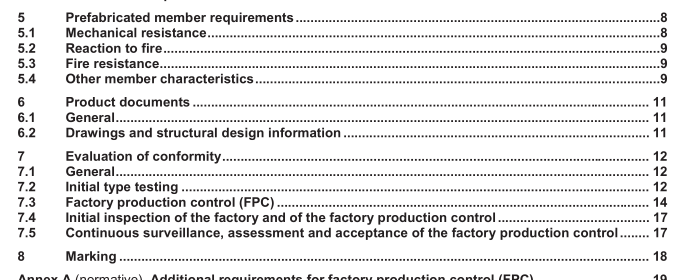EN 14250:2010 – Timber structures – Product requirements for prefabricated structural members assembled with punched metal plate fasteners

5.1.2 Determination and declaration
The mechanical resistance (i.e. load-bearing capacity and stiffness) of the prefabricated structural member shall be determined and declared according to one of the following methods:
a) Method 1: By reference to dated drawings of the structural member with information on the geometrical data and reference to the material properties of the structural components and punched metal plate fasteners used, necessary to calculate characteristic load-bearing capacities and stiffness according to method(s) valid in the Member State of the intended use of this structural member.
NOTE 1 This method is assumed to reflect Method 1 in Guidance Paper L. By this method the characteristic mechanical resistance is indirectly declared. It may be relevant for a structural member manufactured according to the manufacturer’s specification and put on the market, e.g. on the retailer shelves, without necessarily knowing the works where the member is going to be used.
b) Method 2: Directly, by calculating the characteristic values or design values for the load-bearing capacities and stiffness of the structural member according to the method(s) given in EN 1995-1-1 with possibly reference to the used sets of National Determined Parameters (NDPs), if any, valid in the Member State of the intended use of the structural member.
NOTE 2 This method is assumed to reflect Method 2 in Guidance Paper L. By this method the characteristic mechanical resistance is directly declared. It may be relevant for a structural member manufactured according to the manufacturer’s specification and put on the market without necessarily knowing the works where the member is going to be used, e.g. for catalogue products, like trussed beams.
c) Method 3a: By declaring compliance with the given production documents of the structural member, together with the information on the purchaser and the party responsible for the structural design of the member.
NOTE 3 This method is assumed to reflect Method 3a in Guidance Paper L. By this method the characteristic mechanical resistance is indirectly declared. It may be relevant for a structural member made to measure according to the purchaser’s order.
d) Method 3b: By declaring compliance with a given structural design specification of the structural member produced and held by the manufacturer showing that the member is able to resist all the relevant actions affecting it in the ultimate limit state and satisfies specified serviceability requirements in a specific part of works. Structural design specification of the member is based on information (e.g. actions and deflection limits) from a specific part of works according to the design requirements in the Member State of its intended use (EN 1990, EN 1991 and EN 1995-1-1), with possibly reference to the relevant National Annexes defining the National Determined Parameters/method(s) valid in the Member State of the intended use of the structural member.
NOTE 4 This method is assumed to reflect Method 3b in Guidance Paper L. By this method the characteristic mechanical resistance is indirectly declared. It may be relevant for a structural member made to measure according to the structural design specification prepared by the manufacturer when the works where the member will be used is known.
EN 14250:2010 – Timber structures – Product requirements for prefabricated structural members assembled with punched metal plate fasteners